innovative technologies Assignment
VerifiedAdded on 2021/12/14
|11
|3055
|31
AI Summary
Contribute Materials
Your contribution can guide someone’s learning journey. Share your
documents today.

SOUTHERN CROSS UNIVERSITY
Student Name:
Student ID No.:
Unit Name:
Unit Code:
Tutor’s name:
Assignment
No.:
Assignment
Title:
Due date:
Date submitted:
Student Name:
Student ID No.:
Unit Name:
Unit Code:
Tutor’s name:
Assignment
No.:
Assignment
Title:
Due date:
Date submitted:
Secure Best Marks with AI Grader
Need help grading? Try our AI Grader for instant feedback on your assignments.
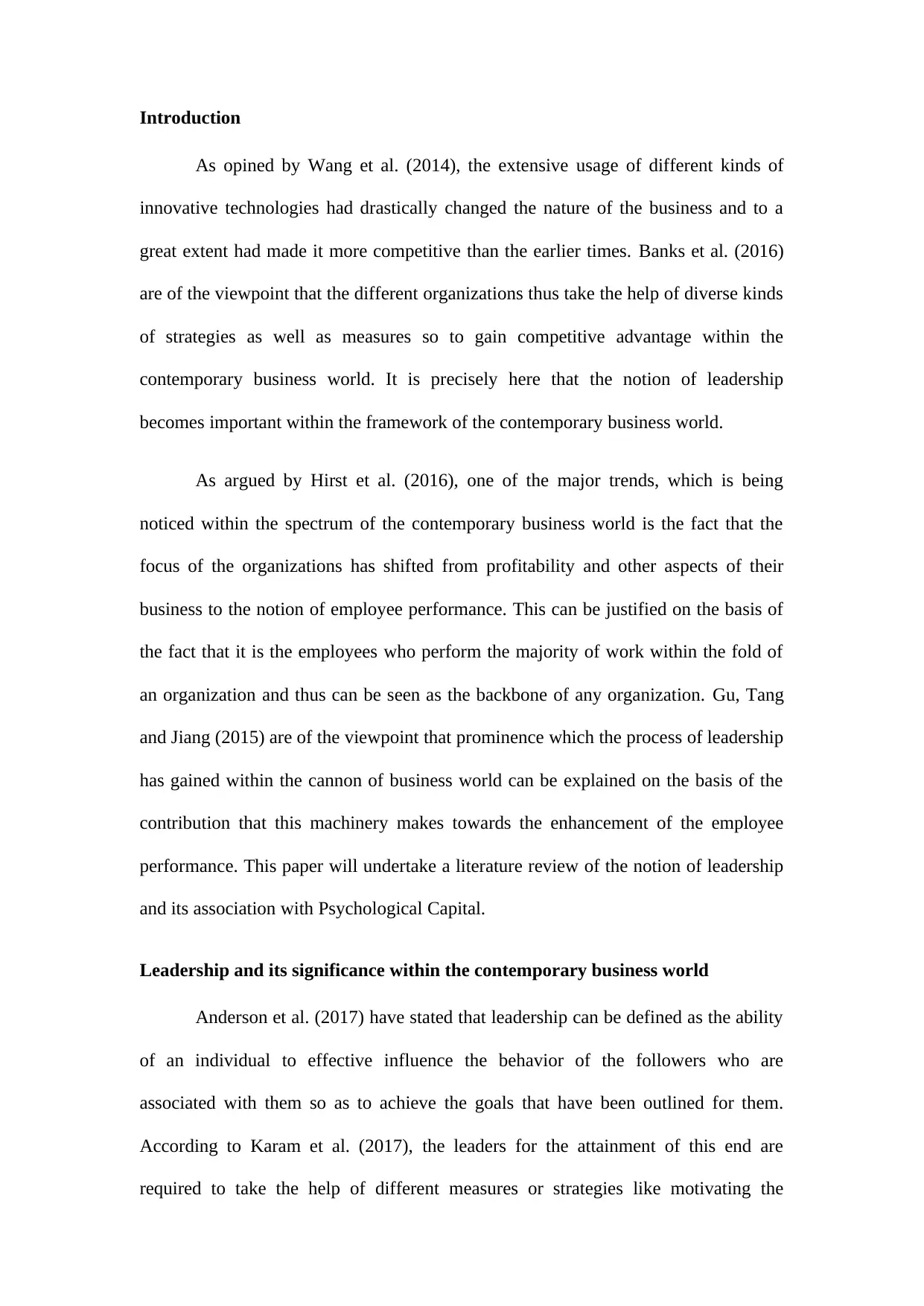
Introduction
As opined by Wang et al. (2014), the extensive usage of different kinds of
innovative technologies had drastically changed the nature of the business and to a
great extent had made it more competitive than the earlier times. Banks et al. (2016)
are of the viewpoint that the different organizations thus take the help of diverse kinds
of strategies as well as measures so to gain competitive advantage within the
contemporary business world. It is precisely here that the notion of leadership
becomes important within the framework of the contemporary business world.
As argued by Hirst et al. (2016), one of the major trends, which is being
noticed within the spectrum of the contemporary business world is the fact that the
focus of the organizations has shifted from profitability and other aspects of their
business to the notion of employee performance. This can be justified on the basis of
the fact that it is the employees who perform the majority of work within the fold of
an organization and thus can be seen as the backbone of any organization. Gu, Tang
and Jiang (2015) are of the viewpoint that prominence which the process of leadership
has gained within the cannon of business world can be explained on the basis of the
contribution that this machinery makes towards the enhancement of the employee
performance. This paper will undertake a literature review of the notion of leadership
and its association with Psychological Capital.
Leadership and its significance within the contemporary business world
Anderson et al. (2017) have stated that leadership can be defined as the ability
of an individual to effective influence the behavior of the followers who are
associated with them so as to achieve the goals that have been outlined for them.
According to Karam et al. (2017), the leaders for the attainment of this end are
required to take the help of different measures or strategies like motivating the
As opined by Wang et al. (2014), the extensive usage of different kinds of
innovative technologies had drastically changed the nature of the business and to a
great extent had made it more competitive than the earlier times. Banks et al. (2016)
are of the viewpoint that the different organizations thus take the help of diverse kinds
of strategies as well as measures so to gain competitive advantage within the
contemporary business world. It is precisely here that the notion of leadership
becomes important within the framework of the contemporary business world.
As argued by Hirst et al. (2016), one of the major trends, which is being
noticed within the spectrum of the contemporary business world is the fact that the
focus of the organizations has shifted from profitability and other aspects of their
business to the notion of employee performance. This can be justified on the basis of
the fact that it is the employees who perform the majority of work within the fold of
an organization and thus can be seen as the backbone of any organization. Gu, Tang
and Jiang (2015) are of the viewpoint that prominence which the process of leadership
has gained within the cannon of business world can be explained on the basis of the
contribution that this machinery makes towards the enhancement of the employee
performance. This paper will undertake a literature review of the notion of leadership
and its association with Psychological Capital.
Leadership and its significance within the contemporary business world
Anderson et al. (2017) have stated that leadership can be defined as the ability
of an individual to effective influence the behavior of the followers who are
associated with them so as to achieve the goals that have been outlined for them.
According to Karam et al. (2017), the leaders for the attainment of this end are
required to take the help of different measures or strategies like motivating the
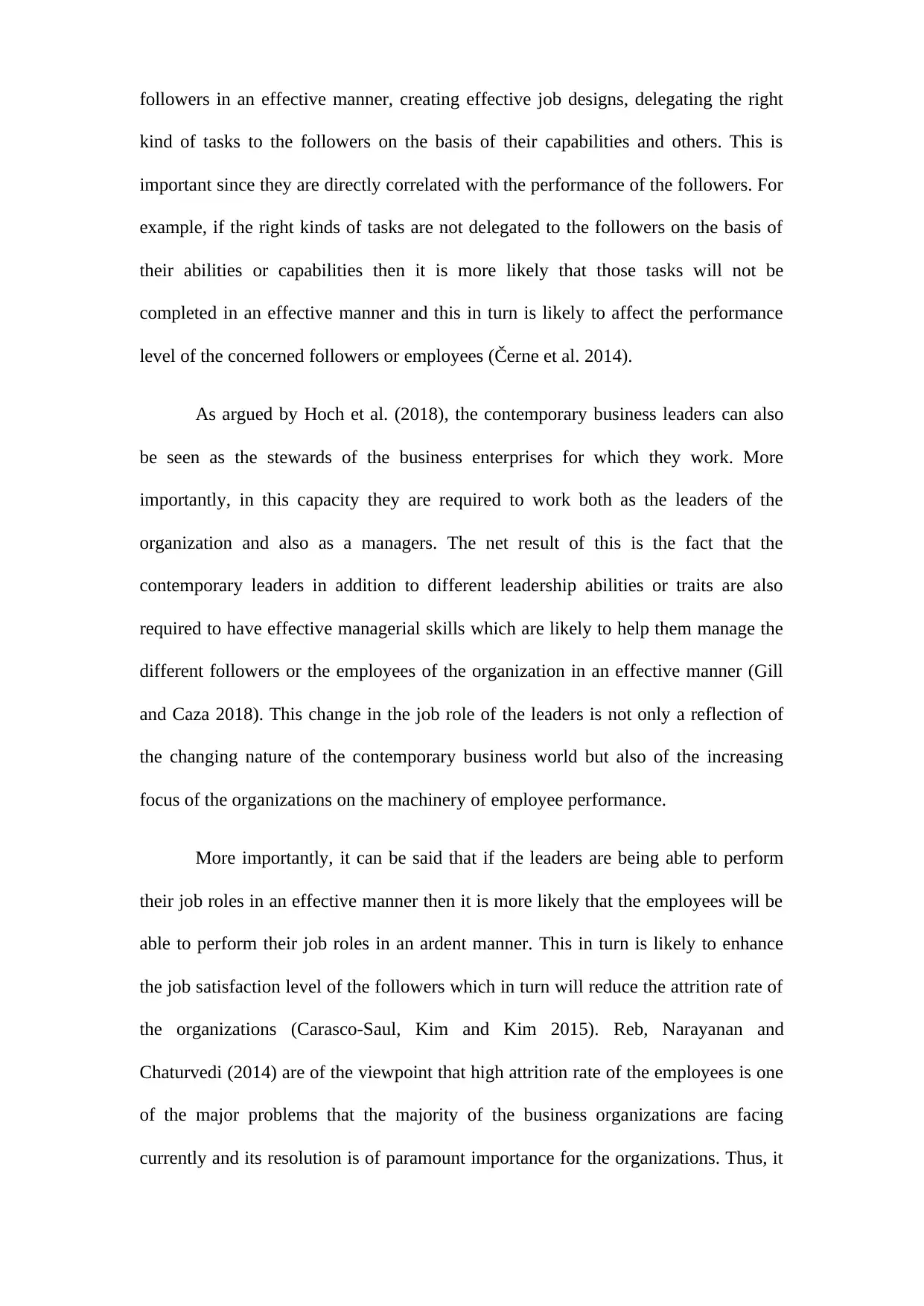
followers in an effective manner, creating effective job designs, delegating the right
kind of tasks to the followers on the basis of their capabilities and others. This is
important since they are directly correlated with the performance of the followers. For
example, if the right kinds of tasks are not delegated to the followers on the basis of
their abilities or capabilities then it is more likely that those tasks will not be
completed in an effective manner and this in turn is likely to affect the performance
level of the concerned followers or employees (Černe et al. 2014).
As argued by Hoch et al. (2018), the contemporary business leaders can also
be seen as the stewards of the business enterprises for which they work. More
importantly, in this capacity they are required to work both as the leaders of the
organization and also as a managers. The net result of this is the fact that the
contemporary leaders in addition to different leadership abilities or traits are also
required to have effective managerial skills which are likely to help them manage the
different followers or the employees of the organization in an effective manner (Gill
and Caza 2018). This change in the job role of the leaders is not only a reflection of
the changing nature of the contemporary business world but also of the increasing
focus of the organizations on the machinery of employee performance.
More importantly, it can be said that if the leaders are being able to perform
their job roles in an effective manner then it is more likely that the employees will be
able to perform their job roles in an ardent manner. This in turn is likely to enhance
the job satisfaction level of the followers which in turn will reduce the attrition rate of
the organizations (Carasco-Saul, Kim and Kim 2015). Reb, Narayanan and
Chaturvedi (2014) are of the viewpoint that high attrition rate of the employees is one
of the major problems that the majority of the business organizations are facing
currently and its resolution is of paramount importance for the organizations. Thus, it
kind of tasks to the followers on the basis of their capabilities and others. This is
important since they are directly correlated with the performance of the followers. For
example, if the right kinds of tasks are not delegated to the followers on the basis of
their abilities or capabilities then it is more likely that those tasks will not be
completed in an effective manner and this in turn is likely to affect the performance
level of the concerned followers or employees (Černe et al. 2014).
As argued by Hoch et al. (2018), the contemporary business leaders can also
be seen as the stewards of the business enterprises for which they work. More
importantly, in this capacity they are required to work both as the leaders of the
organization and also as a managers. The net result of this is the fact that the
contemporary leaders in addition to different leadership abilities or traits are also
required to have effective managerial skills which are likely to help them manage the
different followers or the employees of the organization in an effective manner (Gill
and Caza 2018). This change in the job role of the leaders is not only a reflection of
the changing nature of the contemporary business world but also of the increasing
focus of the organizations on the machinery of employee performance.
More importantly, it can be said that if the leaders are being able to perform
their job roles in an effective manner then it is more likely that the employees will be
able to perform their job roles in an ardent manner. This in turn is likely to enhance
the job satisfaction level of the followers which in turn will reduce the attrition rate of
the organizations (Carasco-Saul, Kim and Kim 2015). Reb, Narayanan and
Chaturvedi (2014) are of the viewpoint that high attrition rate of the employees is one
of the major problems that the majority of the business organizations are facing
currently and its resolution is of paramount importance for the organizations. Thus, it
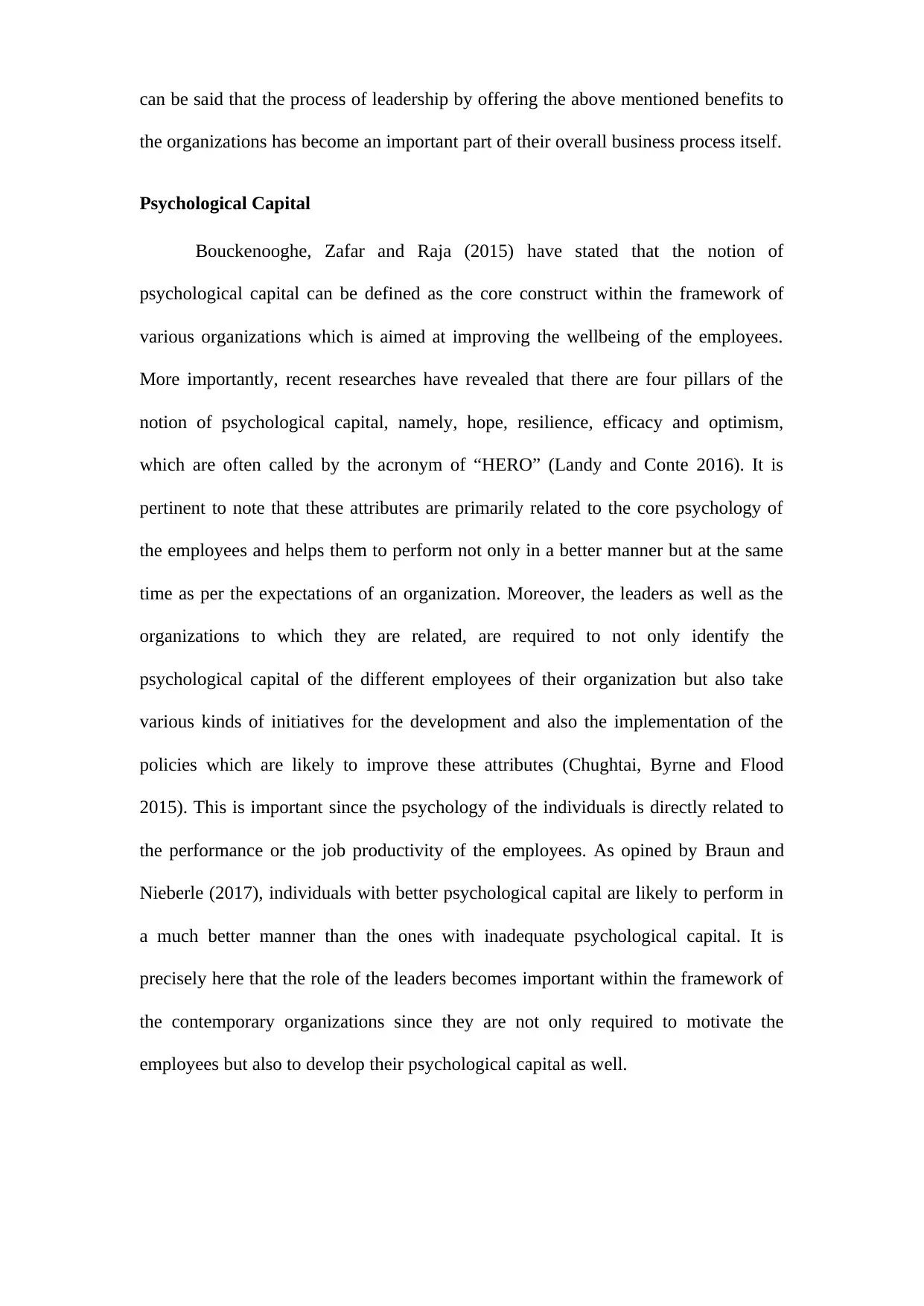
can be said that the process of leadership by offering the above mentioned benefits to
the organizations has become an important part of their overall business process itself.
Psychological Capital
Bouckenooghe, Zafar and Raja (2015) have stated that the notion of
psychological capital can be defined as the core construct within the framework of
various organizations which is aimed at improving the wellbeing of the employees.
More importantly, recent researches have revealed that there are four pillars of the
notion of psychological capital, namely, hope, resilience, efficacy and optimism,
which are often called by the acronym of “HERO” (Landy and Conte 2016). It is
pertinent to note that these attributes are primarily related to the core psychology of
the employees and helps them to perform not only in a better manner but at the same
time as per the expectations of an organization. Moreover, the leaders as well as the
organizations to which they are related, are required to not only identify the
psychological capital of the different employees of their organization but also take
various kinds of initiatives for the development and also the implementation of the
policies which are likely to improve these attributes (Chughtai, Byrne and Flood
2015). This is important since the psychology of the individuals is directly related to
the performance or the job productivity of the employees. As opined by Braun and
Nieberle (2017), individuals with better psychological capital are likely to perform in
a much better manner than the ones with inadequate psychological capital. It is
precisely here that the role of the leaders becomes important within the framework of
the contemporary organizations since they are not only required to motivate the
employees but also to develop their psychological capital as well.
the organizations has become an important part of their overall business process itself.
Psychological Capital
Bouckenooghe, Zafar and Raja (2015) have stated that the notion of
psychological capital can be defined as the core construct within the framework of
various organizations which is aimed at improving the wellbeing of the employees.
More importantly, recent researches have revealed that there are four pillars of the
notion of psychological capital, namely, hope, resilience, efficacy and optimism,
which are often called by the acronym of “HERO” (Landy and Conte 2016). It is
pertinent to note that these attributes are primarily related to the core psychology of
the employees and helps them to perform not only in a better manner but at the same
time as per the expectations of an organization. Moreover, the leaders as well as the
organizations to which they are related, are required to not only identify the
psychological capital of the different employees of their organization but also take
various kinds of initiatives for the development and also the implementation of the
policies which are likely to improve these attributes (Chughtai, Byrne and Flood
2015). This is important since the psychology of the individuals is directly related to
the performance or the job productivity of the employees. As opined by Braun and
Nieberle (2017), individuals with better psychological capital are likely to perform in
a much better manner than the ones with inadequate psychological capital. It is
precisely here that the role of the leaders becomes important within the framework of
the contemporary organizations since they are not only required to motivate the
employees but also to develop their psychological capital as well.
Secure Best Marks with AI Grader
Need help grading? Try our AI Grader for instant feedback on your assignments.
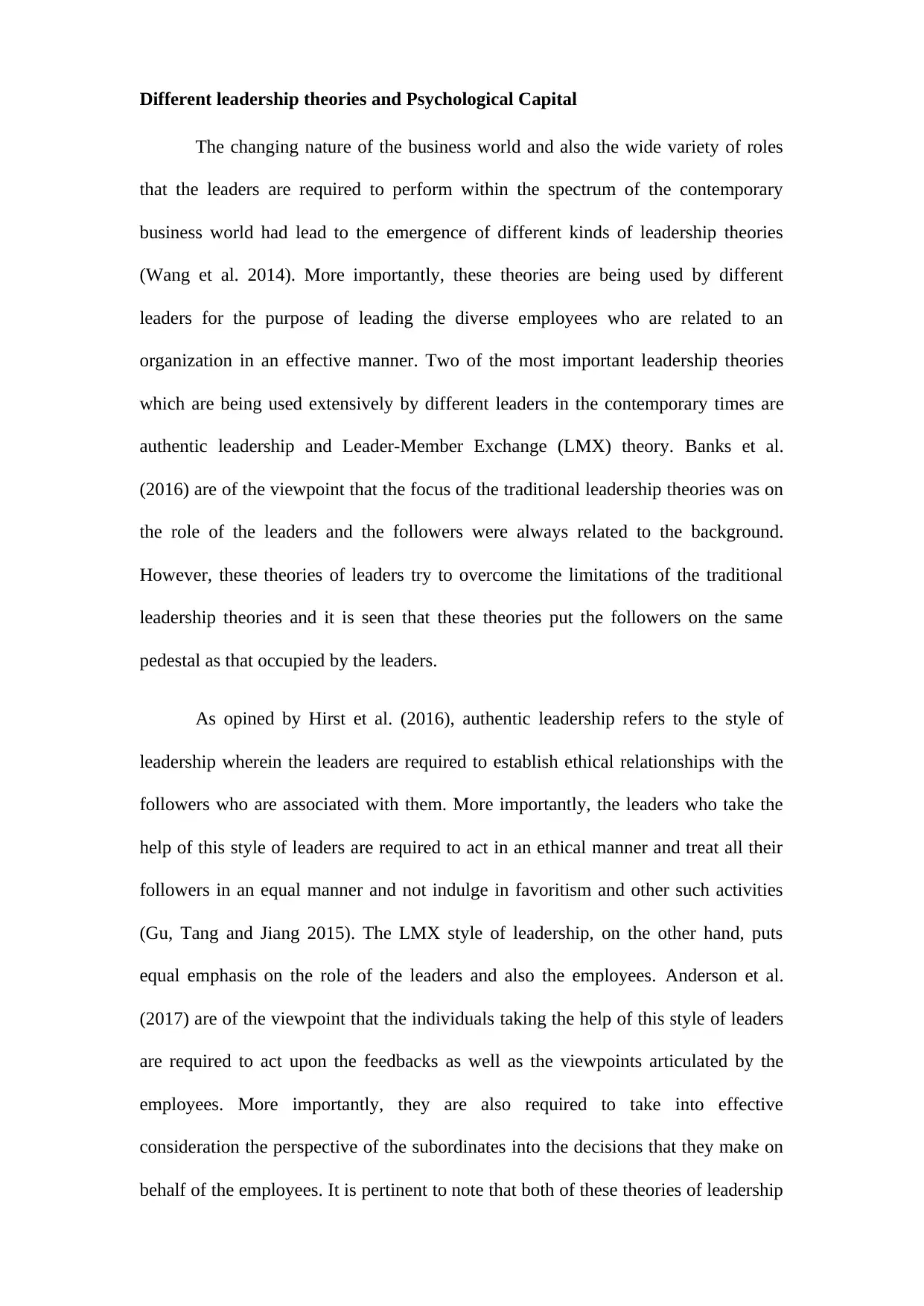
Different leadership theories and Psychological Capital
The changing nature of the business world and also the wide variety of roles
that the leaders are required to perform within the spectrum of the contemporary
business world had lead to the emergence of different kinds of leadership theories
(Wang et al. 2014). More importantly, these theories are being used by different
leaders for the purpose of leading the diverse employees who are related to an
organization in an effective manner. Two of the most important leadership theories
which are being used extensively by different leaders in the contemporary times are
authentic leadership and Leader-Member Exchange (LMX) theory. Banks et al.
(2016) are of the viewpoint that the focus of the traditional leadership theories was on
the role of the leaders and the followers were always related to the background.
However, these theories of leaders try to overcome the limitations of the traditional
leadership theories and it is seen that these theories put the followers on the same
pedestal as that occupied by the leaders.
As opined by Hirst et al. (2016), authentic leadership refers to the style of
leadership wherein the leaders are required to establish ethical relationships with the
followers who are associated with them. More importantly, the leaders who take the
help of this style of leaders are required to act in an ethical manner and treat all their
followers in an equal manner and not indulge in favoritism and other such activities
(Gu, Tang and Jiang 2015). The LMX style of leadership, on the other hand, puts
equal emphasis on the role of the leaders and also the employees. Anderson et al.
(2017) are of the viewpoint that the individuals taking the help of this style of leaders
are required to act upon the feedbacks as well as the viewpoints articulated by the
employees. More importantly, they are also required to take into effective
consideration the perspective of the subordinates into the decisions that they make on
behalf of the employees. It is pertinent to note that both of these theories of leadership
The changing nature of the business world and also the wide variety of roles
that the leaders are required to perform within the spectrum of the contemporary
business world had lead to the emergence of different kinds of leadership theories
(Wang et al. 2014). More importantly, these theories are being used by different
leaders for the purpose of leading the diverse employees who are related to an
organization in an effective manner. Two of the most important leadership theories
which are being used extensively by different leaders in the contemporary times are
authentic leadership and Leader-Member Exchange (LMX) theory. Banks et al.
(2016) are of the viewpoint that the focus of the traditional leadership theories was on
the role of the leaders and the followers were always related to the background.
However, these theories of leaders try to overcome the limitations of the traditional
leadership theories and it is seen that these theories put the followers on the same
pedestal as that occupied by the leaders.
As opined by Hirst et al. (2016), authentic leadership refers to the style of
leadership wherein the leaders are required to establish ethical relationships with the
followers who are associated with them. More importantly, the leaders who take the
help of this style of leaders are required to act in an ethical manner and treat all their
followers in an equal manner and not indulge in favoritism and other such activities
(Gu, Tang and Jiang 2015). The LMX style of leadership, on the other hand, puts
equal emphasis on the role of the leaders and also the employees. Anderson et al.
(2017) are of the viewpoint that the individuals taking the help of this style of leaders
are required to act upon the feedbacks as well as the viewpoints articulated by the
employees. More importantly, they are also required to take into effective
consideration the perspective of the subordinates into the decisions that they make on
behalf of the employees. It is pertinent to note that both of these theories of leadership
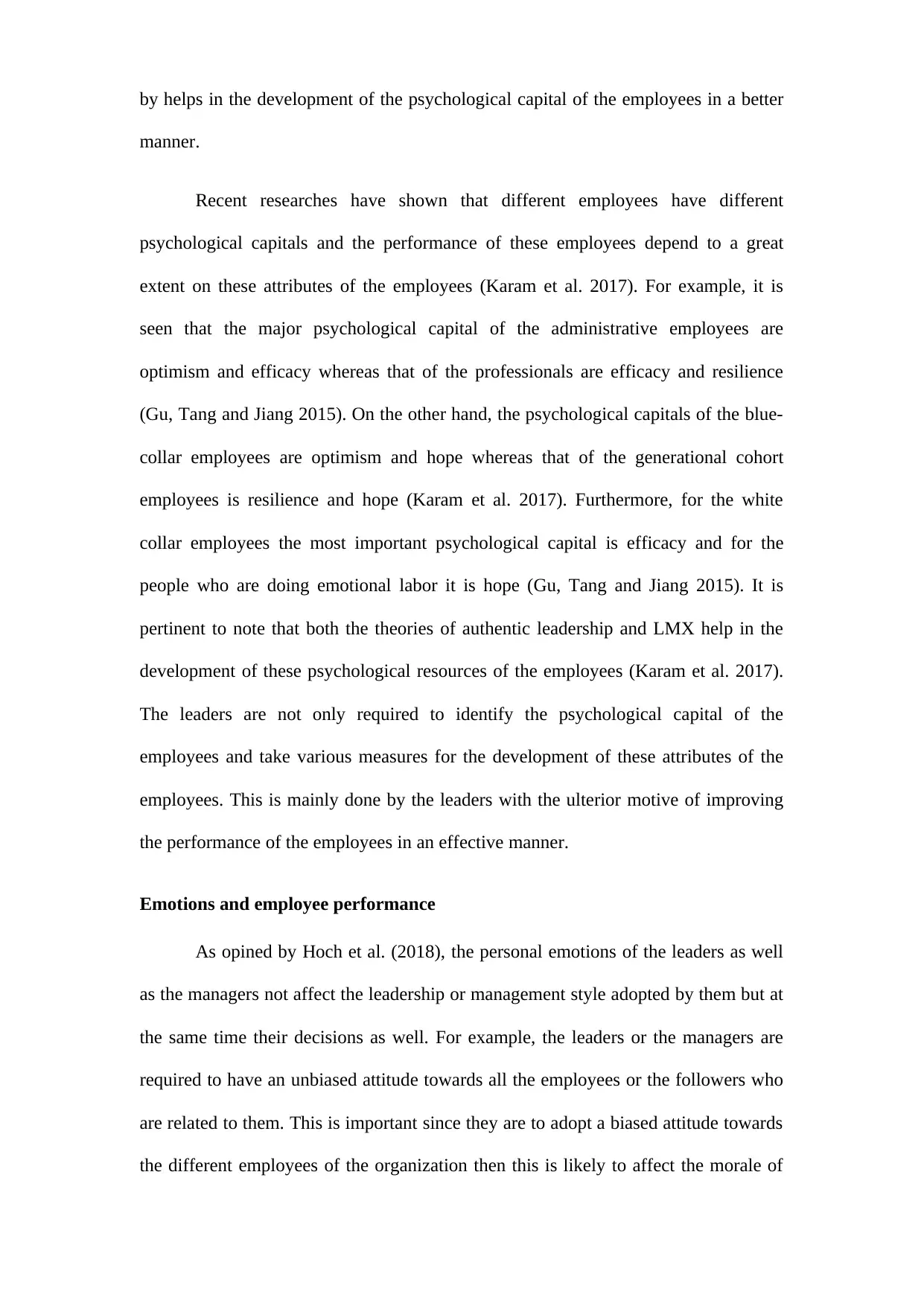
by helps in the development of the psychological capital of the employees in a better
manner.
Recent researches have shown that different employees have different
psychological capitals and the performance of these employees depend to a great
extent on these attributes of the employees (Karam et al. 2017). For example, it is
seen that the major psychological capital of the administrative employees are
optimism and efficacy whereas that of the professionals are efficacy and resilience
(Gu, Tang and Jiang 2015). On the other hand, the psychological capitals of the blue-
collar employees are optimism and hope whereas that of the generational cohort
employees is resilience and hope (Karam et al. 2017). Furthermore, for the white
collar employees the most important psychological capital is efficacy and for the
people who are doing emotional labor it is hope (Gu, Tang and Jiang 2015). It is
pertinent to note that both the theories of authentic leadership and LMX help in the
development of these psychological resources of the employees (Karam et al. 2017).
The leaders are not only required to identify the psychological capital of the
employees and take various measures for the development of these attributes of the
employees. This is mainly done by the leaders with the ulterior motive of improving
the performance of the employees in an effective manner.
Emotions and employee performance
As opined by Hoch et al. (2018), the personal emotions of the leaders as well
as the managers not affect the leadership or management style adopted by them but at
the same time their decisions as well. For example, the leaders or the managers are
required to have an unbiased attitude towards all the employees or the followers who
are related to them. This is important since they are to adopt a biased attitude towards
the different employees of the organization then this is likely to affect the morale of
manner.
Recent researches have shown that different employees have different
psychological capitals and the performance of these employees depend to a great
extent on these attributes of the employees (Karam et al. 2017). For example, it is
seen that the major psychological capital of the administrative employees are
optimism and efficacy whereas that of the professionals are efficacy and resilience
(Gu, Tang and Jiang 2015). On the other hand, the psychological capitals of the blue-
collar employees are optimism and hope whereas that of the generational cohort
employees is resilience and hope (Karam et al. 2017). Furthermore, for the white
collar employees the most important psychological capital is efficacy and for the
people who are doing emotional labor it is hope (Gu, Tang and Jiang 2015). It is
pertinent to note that both the theories of authentic leadership and LMX help in the
development of these psychological resources of the employees (Karam et al. 2017).
The leaders are not only required to identify the psychological capital of the
employees and take various measures for the development of these attributes of the
employees. This is mainly done by the leaders with the ulterior motive of improving
the performance of the employees in an effective manner.
Emotions and employee performance
As opined by Hoch et al. (2018), the personal emotions of the leaders as well
as the managers not affect the leadership or management style adopted by them but at
the same time their decisions as well. For example, the leaders or the managers are
required to have an unbiased attitude towards all the employees or the followers who
are related to them. This is important since they are to adopt a biased attitude towards
the different employees of the organization then this is likely to affect the morale of
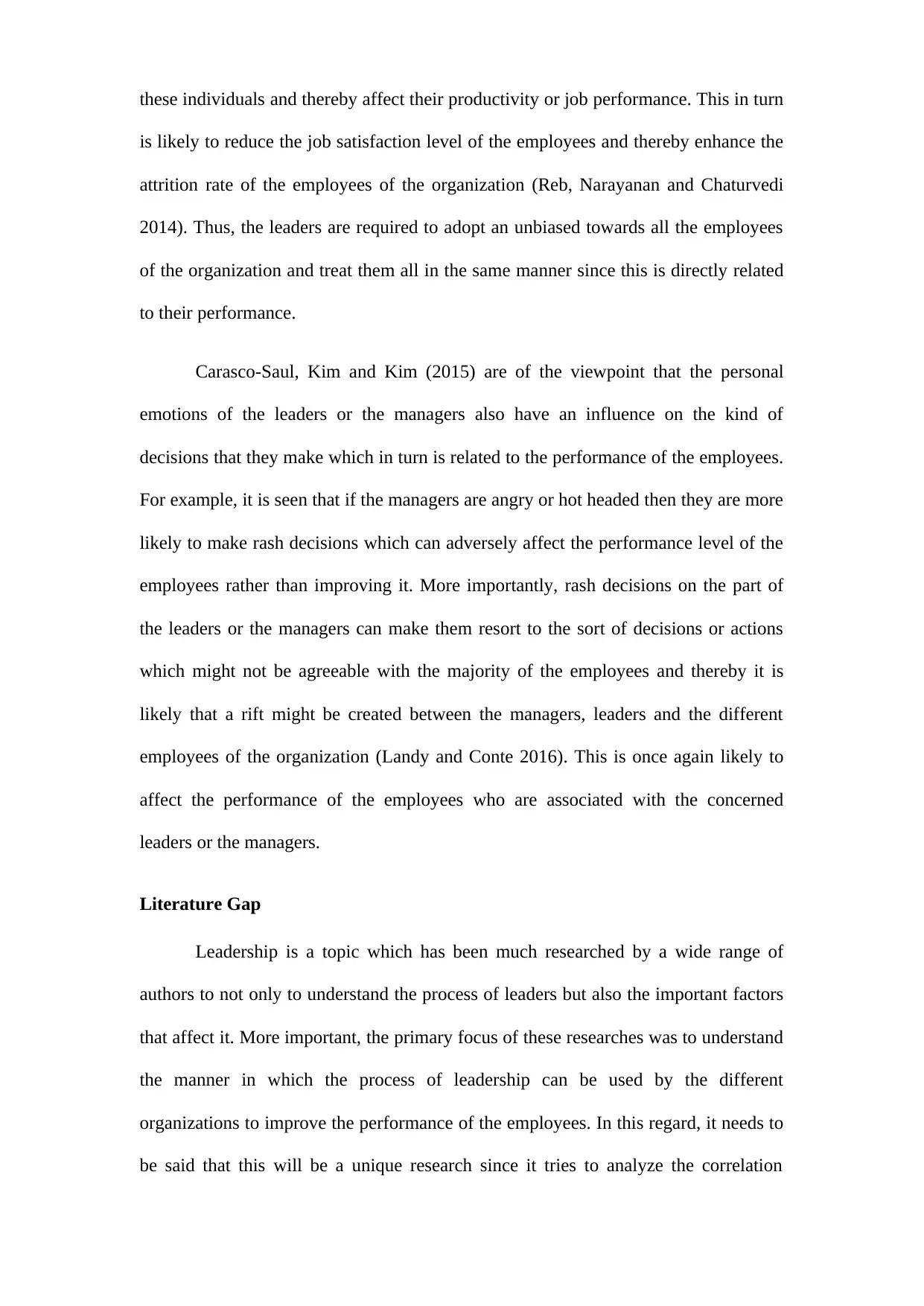
these individuals and thereby affect their productivity or job performance. This in turn
is likely to reduce the job satisfaction level of the employees and thereby enhance the
attrition rate of the employees of the organization (Reb, Narayanan and Chaturvedi
2014). Thus, the leaders are required to adopt an unbiased towards all the employees
of the organization and treat them all in the same manner since this is directly related
to their performance.
Carasco-Saul, Kim and Kim (2015) are of the viewpoint that the personal
emotions of the leaders or the managers also have an influence on the kind of
decisions that they make which in turn is related to the performance of the employees.
For example, it is seen that if the managers are angry or hot headed then they are more
likely to make rash decisions which can adversely affect the performance level of the
employees rather than improving it. More importantly, rash decisions on the part of
the leaders or the managers can make them resort to the sort of decisions or actions
which might not be agreeable with the majority of the employees and thereby it is
likely that a rift might be created between the managers, leaders and the different
employees of the organization (Landy and Conte 2016). This is once again likely to
affect the performance of the employees who are associated with the concerned
leaders or the managers.
Literature Gap
Leadership is a topic which has been much researched by a wide range of
authors to not only to understand the process of leaders but also the important factors
that affect it. More important, the primary focus of these researches was to understand
the manner in which the process of leadership can be used by the different
organizations to improve the performance of the employees. In this regard, it needs to
be said that this will be a unique research since it tries to analyze the correlation
is likely to reduce the job satisfaction level of the employees and thereby enhance the
attrition rate of the employees of the organization (Reb, Narayanan and Chaturvedi
2014). Thus, the leaders are required to adopt an unbiased towards all the employees
of the organization and treat them all in the same manner since this is directly related
to their performance.
Carasco-Saul, Kim and Kim (2015) are of the viewpoint that the personal
emotions of the leaders or the managers also have an influence on the kind of
decisions that they make which in turn is related to the performance of the employees.
For example, it is seen that if the managers are angry or hot headed then they are more
likely to make rash decisions which can adversely affect the performance level of the
employees rather than improving it. More importantly, rash decisions on the part of
the leaders or the managers can make them resort to the sort of decisions or actions
which might not be agreeable with the majority of the employees and thereby it is
likely that a rift might be created between the managers, leaders and the different
employees of the organization (Landy and Conte 2016). This is once again likely to
affect the performance of the employees who are associated with the concerned
leaders or the managers.
Literature Gap
Leadership is a topic which has been much researched by a wide range of
authors to not only to understand the process of leaders but also the important factors
that affect it. More important, the primary focus of these researches was to understand
the manner in which the process of leadership can be used by the different
organizations to improve the performance of the employees. In this regard, it needs to
be said that this will be a unique research since it tries to analyze the correlation
Paraphrase This Document
Need a fresh take? Get an instant paraphrase of this document with our AI Paraphraser
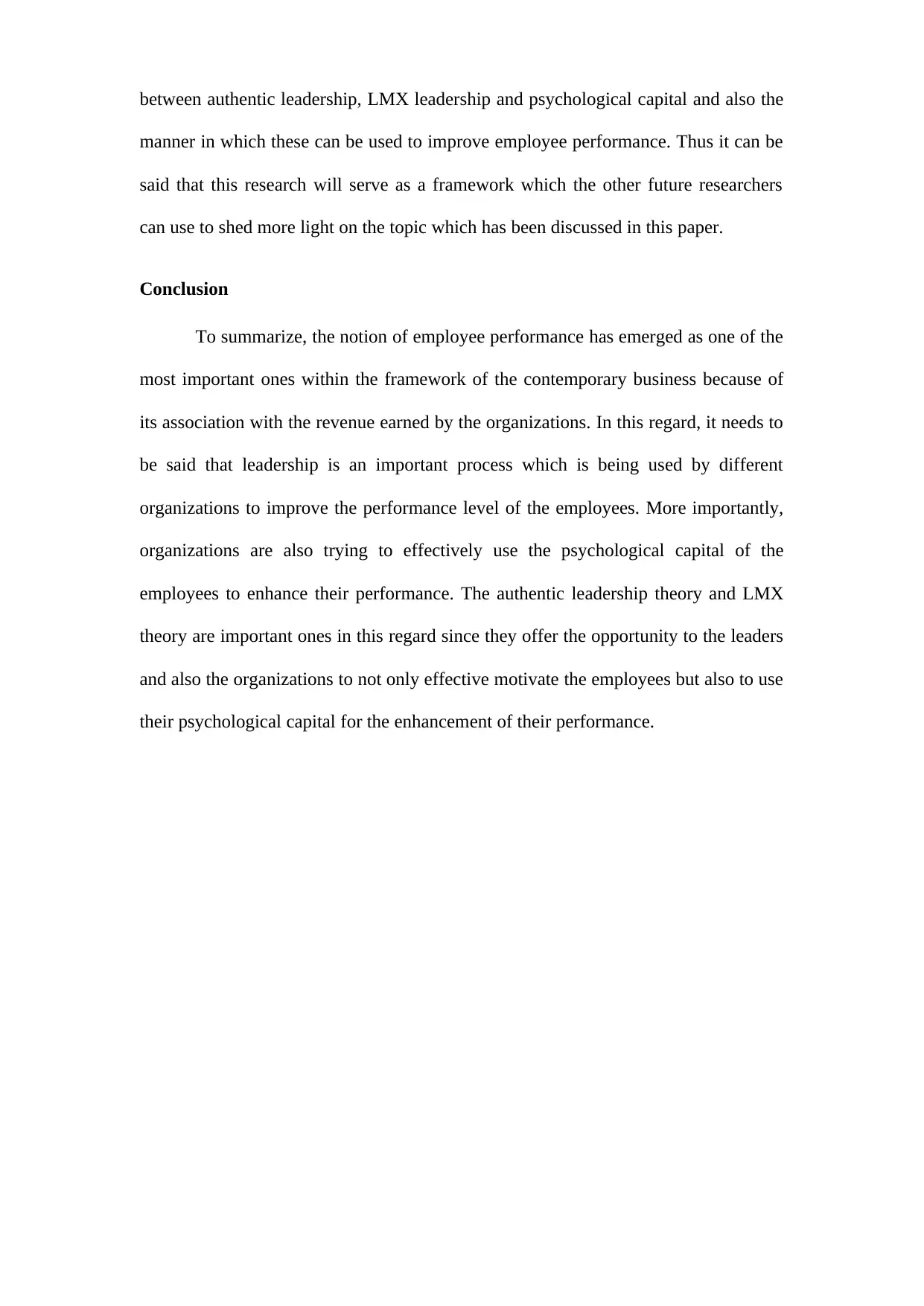
between authentic leadership, LMX leadership and psychological capital and also the
manner in which these can be used to improve employee performance. Thus it can be
said that this research will serve as a framework which the other future researchers
can use to shed more light on the topic which has been discussed in this paper.
Conclusion
To summarize, the notion of employee performance has emerged as one of the
most important ones within the framework of the contemporary business because of
its association with the revenue earned by the organizations. In this regard, it needs to
be said that leadership is an important process which is being used by different
organizations to improve the performance level of the employees. More importantly,
organizations are also trying to effectively use the psychological capital of the
employees to enhance their performance. The authentic leadership theory and LMX
theory are important ones in this regard since they offer the opportunity to the leaders
and also the organizations to not only effective motivate the employees but also to use
their psychological capital for the enhancement of their performance.
manner in which these can be used to improve employee performance. Thus it can be
said that this research will serve as a framework which the other future researchers
can use to shed more light on the topic which has been discussed in this paper.
Conclusion
To summarize, the notion of employee performance has emerged as one of the
most important ones within the framework of the contemporary business because of
its association with the revenue earned by the organizations. In this regard, it needs to
be said that leadership is an important process which is being used by different
organizations to improve the performance level of the employees. More importantly,
organizations are also trying to effectively use the psychological capital of the
employees to enhance their performance. The authentic leadership theory and LMX
theory are important ones in this regard since they offer the opportunity to the leaders
and also the organizations to not only effective motivate the employees but also to use
their psychological capital for the enhancement of their performance.
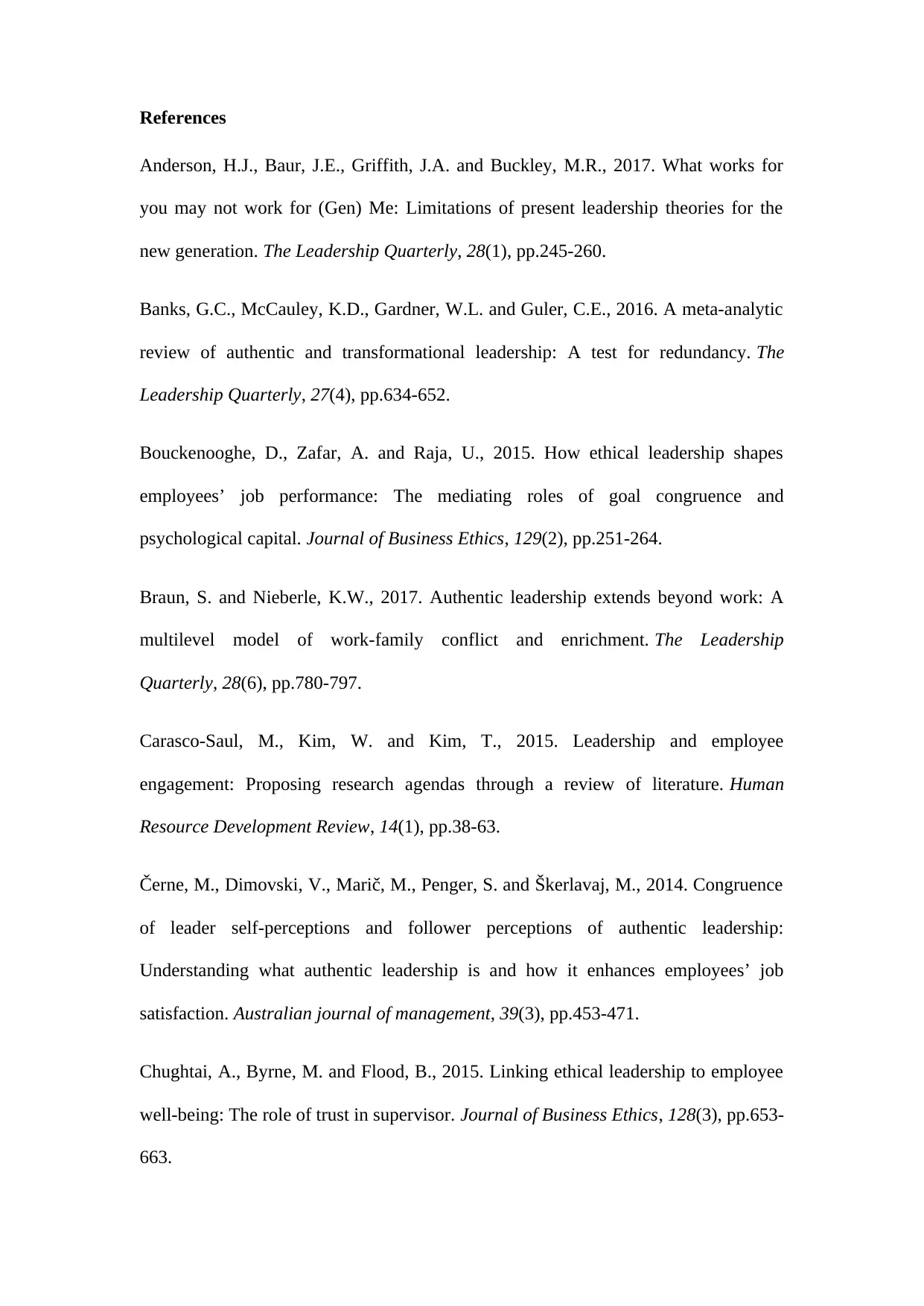
References
Anderson, H.J., Baur, J.E., Griffith, J.A. and Buckley, M.R., 2017. What works for
you may not work for (Gen) Me: Limitations of present leadership theories for the
new generation. The Leadership Quarterly, 28(1), pp.245-260.
Banks, G.C., McCauley, K.D., Gardner, W.L. and Guler, C.E., 2016. A meta-analytic
review of authentic and transformational leadership: A test for redundancy. The
Leadership Quarterly, 27(4), pp.634-652.
Bouckenooghe, D., Zafar, A. and Raja, U., 2015. How ethical leadership shapes
employees’ job performance: The mediating roles of goal congruence and
psychological capital. Journal of Business Ethics, 129(2), pp.251-264.
Braun, S. and Nieberle, K.W., 2017. Authentic leadership extends beyond work: A
multilevel model of work-family conflict and enrichment. The Leadership
Quarterly, 28(6), pp.780-797.
Carasco-Saul, M., Kim, W. and Kim, T., 2015. Leadership and employee
engagement: Proposing research agendas through a review of literature. Human
Resource Development Review, 14(1), pp.38-63.
Černe, M., Dimovski, V., Marič, M., Penger, S. and Škerlavaj, M., 2014. Congruence
of leader self-perceptions and follower perceptions of authentic leadership:
Understanding what authentic leadership is and how it enhances employees’ job
satisfaction. Australian journal of management, 39(3), pp.453-471.
Chughtai, A., Byrne, M. and Flood, B., 2015. Linking ethical leadership to employee
well-being: The role of trust in supervisor. Journal of Business Ethics, 128(3), pp.653-
663.
Anderson, H.J., Baur, J.E., Griffith, J.A. and Buckley, M.R., 2017. What works for
you may not work for (Gen) Me: Limitations of present leadership theories for the
new generation. The Leadership Quarterly, 28(1), pp.245-260.
Banks, G.C., McCauley, K.D., Gardner, W.L. and Guler, C.E., 2016. A meta-analytic
review of authentic and transformational leadership: A test for redundancy. The
Leadership Quarterly, 27(4), pp.634-652.
Bouckenooghe, D., Zafar, A. and Raja, U., 2015. How ethical leadership shapes
employees’ job performance: The mediating roles of goal congruence and
psychological capital. Journal of Business Ethics, 129(2), pp.251-264.
Braun, S. and Nieberle, K.W., 2017. Authentic leadership extends beyond work: A
multilevel model of work-family conflict and enrichment. The Leadership
Quarterly, 28(6), pp.780-797.
Carasco-Saul, M., Kim, W. and Kim, T., 2015. Leadership and employee
engagement: Proposing research agendas through a review of literature. Human
Resource Development Review, 14(1), pp.38-63.
Černe, M., Dimovski, V., Marič, M., Penger, S. and Škerlavaj, M., 2014. Congruence
of leader self-perceptions and follower perceptions of authentic leadership:
Understanding what authentic leadership is and how it enhances employees’ job
satisfaction. Australian journal of management, 39(3), pp.453-471.
Chughtai, A., Byrne, M. and Flood, B., 2015. Linking ethical leadership to employee
well-being: The role of trust in supervisor. Journal of Business Ethics, 128(3), pp.653-
663.
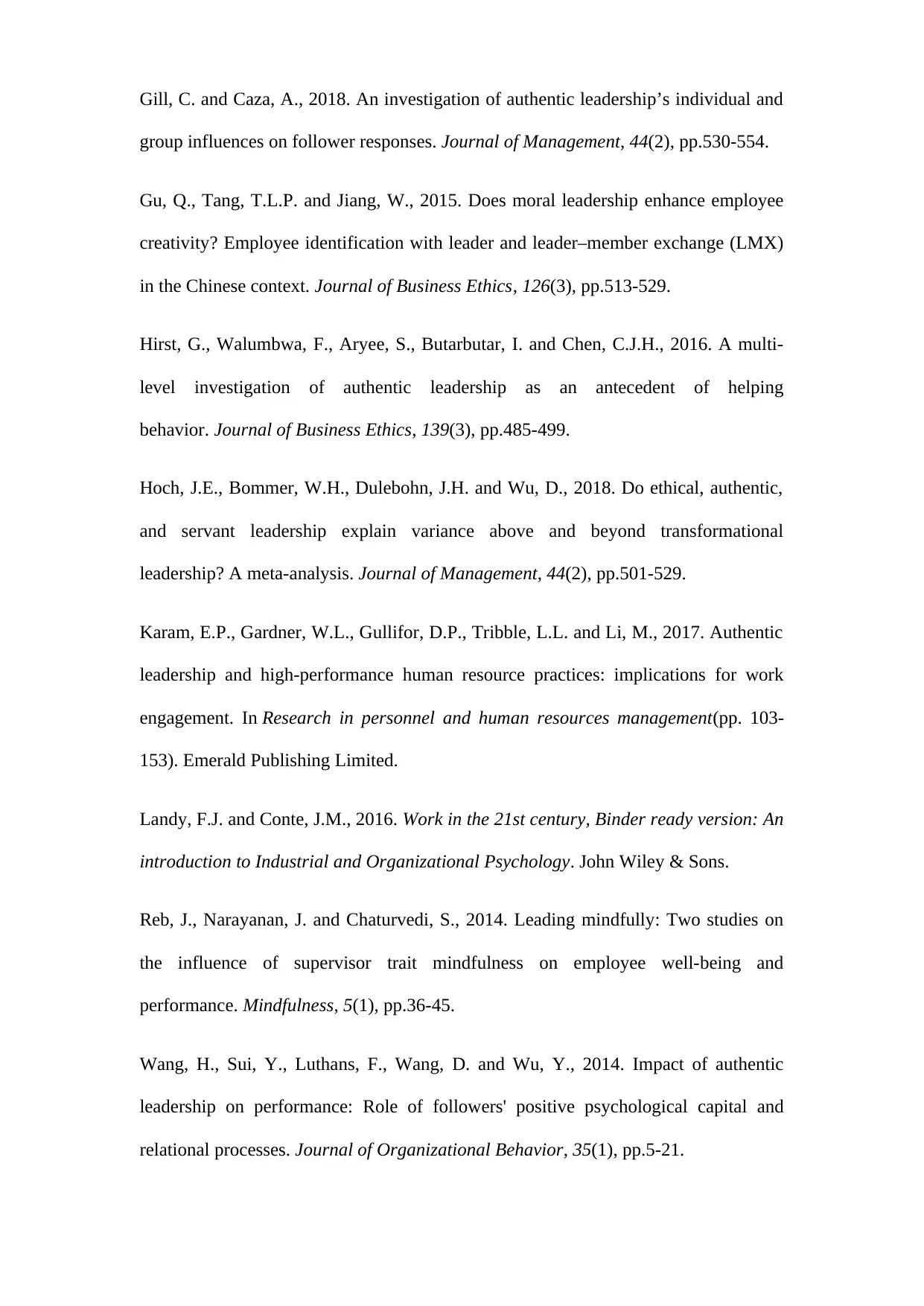
Gill, C. and Caza, A., 2018. An investigation of authentic leadership’s individual and
group influences on follower responses. Journal of Management, 44(2), pp.530-554.
Gu, Q., Tang, T.L.P. and Jiang, W., 2015. Does moral leadership enhance employee
creativity? Employee identification with leader and leader–member exchange (LMX)
in the Chinese context. Journal of Business Ethics, 126(3), pp.513-529.
Hirst, G., Walumbwa, F., Aryee, S., Butarbutar, I. and Chen, C.J.H., 2016. A multi-
level investigation of authentic leadership as an antecedent of helping
behavior. Journal of Business Ethics, 139(3), pp.485-499.
Hoch, J.E., Bommer, W.H., Dulebohn, J.H. and Wu, D., 2018. Do ethical, authentic,
and servant leadership explain variance above and beyond transformational
leadership? A meta-analysis. Journal of Management, 44(2), pp.501-529.
Karam, E.P., Gardner, W.L., Gullifor, D.P., Tribble, L.L. and Li, M., 2017. Authentic
leadership and high-performance human resource practices: implications for work
engagement. In Research in personnel and human resources management(pp. 103-
153). Emerald Publishing Limited.
Landy, F.J. and Conte, J.M., 2016. Work in the 21st century, Binder ready version: An
introduction to Industrial and Organizational Psychology. John Wiley & Sons.
Reb, J., Narayanan, J. and Chaturvedi, S., 2014. Leading mindfully: Two studies on
the influence of supervisor trait mindfulness on employee well-being and
performance. Mindfulness, 5(1), pp.36-45.
Wang, H., Sui, Y., Luthans, F., Wang, D. and Wu, Y., 2014. Impact of authentic
leadership on performance: Role of followers' positive psychological capital and
relational processes. Journal of Organizational Behavior, 35(1), pp.5-21.
group influences on follower responses. Journal of Management, 44(2), pp.530-554.
Gu, Q., Tang, T.L.P. and Jiang, W., 2015. Does moral leadership enhance employee
creativity? Employee identification with leader and leader–member exchange (LMX)
in the Chinese context. Journal of Business Ethics, 126(3), pp.513-529.
Hirst, G., Walumbwa, F., Aryee, S., Butarbutar, I. and Chen, C.J.H., 2016. A multi-
level investigation of authentic leadership as an antecedent of helping
behavior. Journal of Business Ethics, 139(3), pp.485-499.
Hoch, J.E., Bommer, W.H., Dulebohn, J.H. and Wu, D., 2018. Do ethical, authentic,
and servant leadership explain variance above and beyond transformational
leadership? A meta-analysis. Journal of Management, 44(2), pp.501-529.
Karam, E.P., Gardner, W.L., Gullifor, D.P., Tribble, L.L. and Li, M., 2017. Authentic
leadership and high-performance human resource practices: implications for work
engagement. In Research in personnel and human resources management(pp. 103-
153). Emerald Publishing Limited.
Landy, F.J. and Conte, J.M., 2016. Work in the 21st century, Binder ready version: An
introduction to Industrial and Organizational Psychology. John Wiley & Sons.
Reb, J., Narayanan, J. and Chaturvedi, S., 2014. Leading mindfully: Two studies on
the influence of supervisor trait mindfulness on employee well-being and
performance. Mindfulness, 5(1), pp.36-45.
Wang, H., Sui, Y., Luthans, F., Wang, D. and Wu, Y., 2014. Impact of authentic
leadership on performance: Role of followers' positive psychological capital and
relational processes. Journal of Organizational Behavior, 35(1), pp.5-21.
Secure Best Marks with AI Grader
Need help grading? Try our AI Grader for instant feedback on your assignments.

1 out of 11
Related Documents
Your All-in-One AI-Powered Toolkit for Academic Success.
+13062052269
info@desklib.com
Available 24*7 on WhatsApp / Email
![[object Object]](/_next/static/media/star-bottom.7253800d.svg)
Unlock your academic potential
© 2024 | Zucol Services PVT LTD | All rights reserved.





